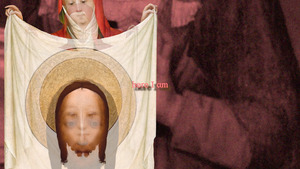wax and stones (dt.: wachs und steine)
Übergeordnete Sets (1)Alle Zusammenhänge anzeigen
Der ausgewählte Medieneintrag wurde diesen Sets hinzugefügt.
1 Inhalte
- Seite 1 von 1
I used to think that I was made of Stone
- Titel
- I used to think that I was made of Stone
- Titel (en)
- I used to think that I was made of Stone
- Autor/in
- Beschreibung (de)
- In der multimedialen Installation „I used to think that I was made of Stone“ werden die Besuchenden Zeug*innen eines nächtlichen Treffens von vier Personen, die nur durch ihre Stimmen präsent sind. Sie unterhalten sich über merkwürdige Objekte in ihrer greifbaren Nähe, führen nebensächliche Gespräche und verbringen einen Abend damit, Musik zu hören und zu tanzen. Ihre Körper bleiben in der Installation unsichtbar, die Objekte im Raum werden zu Spuren.
Durch das Sammeln, neu Arrangieren und Kombinieren von religiösen, (pop-)kulturellen und selbst produzierten Fragmenten im Raum verhandelt „I used to think that I was made of Stone”, wie Lücken und Ausschmückungen unsere Realitäten in der Gegenwart formen und welche Geschichten und Nacherzählungen sie produzieren. Dabei fragt es nach Autor*innenschaft und den Übersetzer*innen, die das Produzierte wortwörtlich über-setzen, weiter-tragen und fort-spinnen und somit stetig weiter produzieren. Sie bestimmen die Stofflichkeit der Geschichte, knoten die Fäden der Ausschmückungen, brennen Löcher und Lücken in das Gewebe und geben es weiter.
- In der multimedialen Installation „I used to think that I was made of Stone“ werden die Besuchenden Zeug*innen eines nächtlichen Treffens von vier Personen, die nur durch ihre Stimmen präsent sind. Sie unterhalten sich über merkwürdige Objekte in ihrer greifbaren Nähe, führen nebensächliche Gespräche und verbringen einen Abend damit, Musik zu hören und zu tanzen. Ihre Körper bleiben in der Installation unsichtbar, die Objekte im Raum werden zu Spuren.
- Beschreibung (en)
- In the multimedia installation “I used to think that I was made of Stone”, visitors witness a nighttime meeting of four people who are only present through their voices. They talk about strange objects within reach, have trivial conversations, and spend an evening listening to music and dancing. Their bodies remain invisible in the installation, while the objects in the room become traces of their presence.
By collecting, rearranging and combining religious, (pop) cultural and self-produced fragments in the space, “I used to think that I was made of Stone” explores how gaps and embellishments shape our realities in the present, and what stories they generate or retell. In doing so, it questions authorship and the role of translators, who literally translate, carry forward, and elaborate on what has already been produced, thus continuing the production process. They determine the material nature of the story, tie the threads of embellishment, burn holes and gaps into the fabric and pass it on.
- In the multimedia installation “I used to think that I was made of Stone”, visitors witness a nighttime meeting of four people who are only present through their voices. They talk about strange objects within reach, have trivial conversations, and spend an evening listening to music and dancing. Their bodies remain invisible in the installation, while the objects in the room become traces of their presence.
- Kategorie
- Typ des Projekts/Werks
- Schlagworte
- Datierung
- Februar 2023
- Mitwirkende
- Sprache
- Abmessungen
- „face imprint” (Textil, Wachs, 63 x 54 cm); „about veronica” (Textil, Stickerei, 84 x 67 cm); „about the cloth” (Projektion, 12 Seiten); „I used to think” (HD-video, Audio, 13:46 min); „toad” (Ton, Wachs, 11 x 13 cm); „wax and stones” (Wachs, Schwelle TV HIFI, 20 x 6 cm); „wax and stone” (Wachs, Stein, 40 x 40 x 10 cm); „everyone” (Reader, 9,5 x 15,2 cm, 36 Seiten); „glasses” (4 Kristallgläser, 5 x 7 cm, Wachs); „jumping rope” (Seil, 2 m); „gestalt mit großem hut” (Keramik, 6 x 7 cm); „fabric n°1” (Textil, Wachs, 57 x 41cm); „fabric n°2” (Textil, Wachs, 60 x 45 cm); „y” (Textil, Wachs, 25 x 15 cm); „woven temple, hidden cocoon #3” (Playlist, 43 Tracks); „wine fountain” (Glas, Pumpe, Wein, 20 x 20 x 110 cm); „cushion” (Textil, Watte, Stickerei, 15 x 15 cm)
- Ort: Institution
- Stadt
- Land
- Titel
- I used to think that I was made of Stone
- Projektleiter/in
- Semester
- Studiengang
- Typ der Abschlussarbeit
- Importiert am
- 25.06.2024
- Übergeordnete Sets
- 2
- Set enthält
- 0 14
